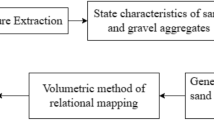Abstract
In order to prevent the abnormal appearance of sand and gravel aggregate level in the concrete mixing plant, and improve the safety of the concrete mixing plant system as well as the efficient and high-quality production of the concrete mixing plant, this paper proposes a method for measuring the height and volume of aggregate material level based on the generation of contour mapping. The method is based on monocular vision technology. Firstly, after obtaining the state of aggregate and the aggregate contour line using YOLOv5 and Unet, the corresponding pixel height is obtained. Secondly, the volume obtained by rotating the aggregate contour line of the camera plane around a specific curve is taken as the pixel volume of the aggregate. After that, the mapping relationship between the pixel height and actual height, the pixel volume and actual volume is established based on the method of least squares. Lastly, by selecting the corresponding mapping relationship through the state of the aggregate and the contour characteristics, the actual height and volume of aggregate in the silo are indirectly computed. The experimental results show that the average accuracy of measuring the height and volume of aggregate in four states of single peak, single valley, double peaks, and double valleys using the contour mapping generated aggregate level height and volume measurement method is 93.68% and 88.33%. The real-time monitoring speed reaches 96 f/s. Both the measurement accuracy and monitoring speed can meet the demand of monitoring the height and volume of aggregate in concrete mixing plant.











Similar content being viewed by others
Data availability
The data that support the findings of this study are available from the corresponding author, [Shuang Yue], upon reasonable request.
References
Zhanbo, L., Jianqiang, L.: Application of intelligent control systems in the sand and gravel aggregate industry. China Plant Eng. 15, 34–35 (2021)
Qinjian, J.: Development report on prefabricated concrete industry from 2014 to 2015. China Concrete 7, 22–24 (2015)
Fen, P., Hua, Y., Xiaonan, Z., Lei, D.: Current situation and suggestions of intelligent construction in sand-gravel aggregate mine. China Min. Mag. 31(09), 75–80 (2022)
Jideng, L.: Research on Sand and Gravel Aggregate Quality Detection based on Image Processing and Deep Learning. Chongqing University of Technology (2021).
Damm, H., Politt, J., Weidenbruch, S., et al.: Radiometric measuring device: US, 2010/0252739A1[P]. 2010–10–07.
Cataldo, A., Vallone, M., Tarricone, L., et al.: An evaluation of performance limits in continuous TDR monitoring of permittivity and levels of liquid materials. Measurement 41(7), 719–730 (2008)
Qi, W., Bin, C.: Application of coal level monitoring system based on radar level indicator in coal warehouses. Coal Mine Mach. 36(08), 301–303 (2015). https://doi.org/10.13436/j.mkjx.201508117
Turner, A.P., Jackson, J.J., Koeninger, N.K., et al.: Stored grain volume measurement using a low density point cloud. Appl. Eng. Agric. Am. Soc. Agric. Biol. Eng. 33(1), 105–112 (2017)
Xiaochun, H., Guoping, J., Xiaoguo, J., Lixin, Z., Min, Y., Ruyong, D.: Research and application of inventory system in outdoor coal yard based on UAV. Power Syst. Eng. 36(05), 64–66 (2020)
Ying, C., Junmin, P.: Volume measurement method of large material stack based on computer vision. J. Shanghai Jiaotong Univ. (2002). https://doi.org/10.16183/j.cnki.jsjtu.2002.07.021
He, H., Chen, T., Zeng, H., et al.: Ground control point-free unmanned aerial vehicle-based photogrammetry for volume estimation of stockpiles carried on barges. Sens. MDPI 19(16), 3534–3555 (2019)
Le, L.: Research on measurement method of irregular object volume based on binocular stereo vision. Xi’an University of Technology (2019).
Rui, M., Yuchen, Z., Zexi, W., Shengchang, G., Tao, Z., Meili, W., Xiaoping, H.: Recognizing stripe rust and yellow dwarf of wheat using improved faster-RCNN. Trans. o Chin. Soc. Agric. Eng. 38(17), 176–185 (2022). https://doi.org/10.11975/j.issn.1002-6819.2022.17.019
Rajeshkumar, G., Braveen, M., Venkatesh, R., et al.: Smart office automation via faster R-CNN based face recognition and internet of things. Meas. Sens. 100719 (2023).
Shuo, Z.: Design of Unmanned Platform Target Recognition and Tracking System based on Machine Vision. Nanjing University of Science and Technology (2018).
Chen, A., Jacob, M., Shoshani, G., et al.: Using computer vision, image analysis and UAVs for the automatic recognition and counting of common cranes (Grus grus). J. Environ. Manage. 328, 116948 (2023)
Varadharajan, I., Rathinavelayutham, S.: An efficient lung disease classification from X-ray images using hybrid Mask-RCNN and BiDLSTM. Biomed. Signal Process. Control 81, 104340 (2023)
Kulkarni, R., Minin, E.D.: Towards automatic detection of wildlife trade using machine vision models. Biol. Cons. 279, 109924 (2023)
Acknowledgements
Materials used for experiments are supported by Zhengzhou Sanhe Hydraulic Machinery Co., Ltd. The authors greatly appreciate the support provided by this company.
Funding
This research was funded by Major Science and Technology Project of Henan Province, Zhengzhou major scientific and technological innovation special project, Key scientific research project plan of colleges and universities in Henan Province, Grant Numbers are 201110210300, 2019CXZX0050, and 21A510007.
Author information
Authors and Affiliations
Contributions
SY wrote the main manuscript text, all authors reviewed the manuscript.
Corresponding author
Ethics declarations
Conflict of interests
The authors declare that they have no known competing financial interests or personal relationships that could have appeared to influence the work reported in this paper.
Ethical approval
My research guide reviewed and ethically approved this manuscript for publishing in this journal.
Human and animal rights
This article does not contain any studies with human or animal subjects performed by any of the authors.
Additional information
Publisher's Note
Springer Nature remains neutral with regard to jurisdictional claims in published maps and institutional affiliations.
Rights and permissions
Springer Nature or its licensor (e.g. a society or other partner) holds exclusive rights to this article under a publishing agreement with the author(s) or other rightsholder(s); author self-archiving of the accepted manuscript version of this article is solely governed by the terms of such publishing agreement and applicable law.
About this article
Cite this article
Liu, Y., Yue, S., Wang, X. et al. Mapping of sand and gravel aggregate level height and volume measurement based on contour mapping generation. SIViP 18, 2865–2878 (2024). https://doi.org/10.1007/s11760-023-02956-7
Received:
Revised:
Accepted:
Published:
Issue Date:
DOI: https://doi.org/10.1007/s11760-023-02956-7




